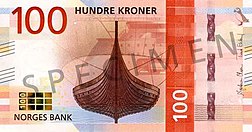
Back Noorse kroon Afrikaans كرونة نروجية Arabic كرونه نروجيه ARZ Norveç kronu Azerbaijani Nuorvegėjės kruona BAT-SMG Нарвежская крона Byelorussian Норвежка крона Bulgarian নরৱেজিয়ান ক্রোনে BPY Norveška kruna BS Corona noruega Catalan
| Norsk krone (Norwegian) | |
|---|---|
 100 kroner banknote obverse | |
| ISO 4217 | |
| Code | NOK (numeric: 578) |
| Subunit | 0.01 |
| Unit | |
| Plural | kroner |
| Symbol | kr |
| Denominations | |
| Subunit | |
| 1⁄100 | øre |
| Plural | |
| øre | øre |
| Banknotes | |
| Freq. used | 50, 100, 200, 500 kroner |
| Rarely used | 1000 kroner |
| Coins | 1, 5, 10, 20 kroner |
| Demographics | |
| Date of introduction | 1875 |
| Replaced | Norwegian speciedaler |
| User(s) | |
| Issuance | |
| Central bank | Norges Bank |
| Website | www |
| Valuation | |
| Inflation | 2.4% |
| Source | Norges Bank, November 2024 |
| Method | Consumer price index |
The krone (Norwegian: [ˈkrûːnə], abbreviation: kr (also NKr for distinction); code: NOK), plural kroner, is the currency of the Kingdom of Norway (including overseas territories and dependencies). It was traditionally known as the Norwegian crown in English; however, this has fallen out of common usage. It is nominally subdivided into 100 øre, although the last coins denominated in øre were withdrawn in 2012.
The krone was the thirteenth-most-traded currency in the world by value in April 2010, down three positions from 2007.[1]
The Norwegian krone is also informally accepted in many shops in Sweden and Finland that are close to the Norwegian border, and also in some shops in the Danish ferry ports of Hirtshals and Frederikshavn. Norwegians spent 14.1 billion NOK on border shopping in 2015 compared to 10.5 billion NOK spent in 2010. Border shopping is a fairly common practice amongst Norwegians, though it is seldom done on impulse. Money is spent mainly on food articles, alcohol, and tobacco, in that order, usually in bulk or large quantities. This is due to considerably higher taxes and fees on tobacco and alcohol purchased domestically in Norway.[2][3]
- ^ Bank for International Settlements: Triennial Central Bank Survey Archived 27 October 2011 at the Wayback Machine p. 12
- ^ "Mest mat i handlekurven" (in Norwegian Bokmål). ssb.no. 12 July 2011. Archived from the original on 8 August 2016. Retrieved 12 April 2016.
- ^ "NOK 14.1 billion in cross border trade". ssb.no. Archived from the original on 8 August 2016. Retrieved 12 April 2016.